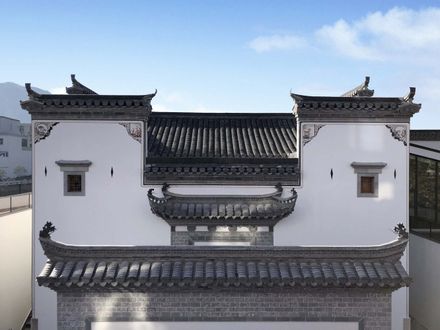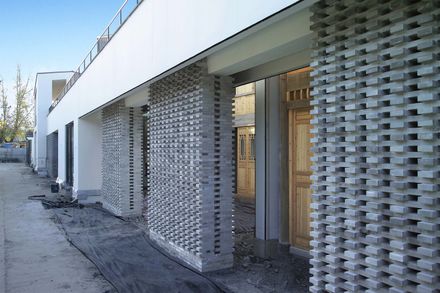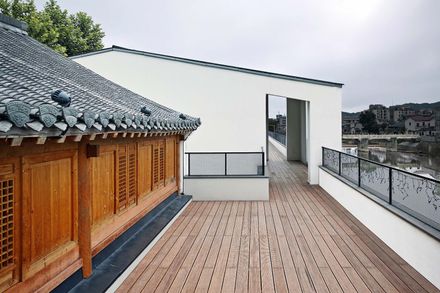Revitalization Of Jingde Shuijie Street
ARCHITECTS
Raw Architecture Studio
DESIGN TEAM
Yawei Li, Shufan Wu, Gang Li, Xiaoyan Wang, Yuanyuan Rui, Rong Sun
MANUFACTURERS
Armstrong
LEAD ARCHITECTS
Yawei Li, Shufan Wu
CONSTRUCTION
Anhui Huizhou Classical Garden Co.,ltd.
TIMBER CONSTRUCTION RENOVATION DESIGN
Anhui Huizhou Classical Garden Co.,ltd.
QCONSTRUCTION DRAWING DESIGN
Construction China Jiangsu International Economic-technical Cooperation Corporation
CLIENT
Jingde County Tourism Development Co., Ltd.
AREA
2148 m²
YEAR
2021
LOCATION
Xuan Cheng, China
CATEGORY
Renovation
Jingde County is situated in Xuancheng City, Anhui Province. It occupies a central position in southern Anhui. Renowned for its pristine natural surroundings, Jingde County is recognized as a "National Ecological County."
Notably, in 2016, it became the inaugural "International Cittaslow City" in Anhui Province. The project site is located in the central area of the county town, at the entrance of the commercial pedestrian street. The site is adjacent to the Huishui River.
It is also the last remaining small historic neighborhood in the central area of the county town. Currently, the structures within the site primarily comprise timber constructions dating back to the Ming and Qing dynasties, accompanied by a few masonry structures that were erected after the establishment of the People's Republic of China.
They are generally ordinary residential houses from historical periods and do not have any preserved cultural heritage status. The current state of the buildings is dilapidated, however.
The primary goal and prerequisite of the planning and design are to evaluate the current physical form and preserve and restore the spatial layout of the historic neighborhood.
At the same time, it is crucial to explore ways to introduce new commercial and leisure functions, allowing the neighborhood to once again fulfill the public life needs of the people of Jingde and sustainably revitalize with new vitality. This becomes a significant proposition in the planning and design process.
Demolition
Protection analysis - The planning and design process begins with a thorough investigation of the current situation.
In conjunction with the structural safety assessments conducted by professional organizations, the team determines the renovation, reconstruction, and demolition classifications for the existing buildings.
Design concept
After the demolition according to the analysis of preservation, the design aims to restore and strengthen the original interface order of the site.
Two types of new volumes are placed: One type is a two-story sloping block that is similar in scale to the old building; The other type is a low and continuous horizontal volume, which connects new and old blocks with the intention of "enclosing walls".
So the design rebuilds an order reflecting the original historical texture and memory of the site.
At the same time, in order to extend the sightseeing experience along the river, the design proposes three concepts: a "sponge" interface, a "narrow space" garden, and a “multi-dimensional” street.
This arrangement forms a continuous and layered space interface while enriching the spatial and visual experiences."sponge" interface: The ground floor shops and a series of courtyards are arranged alternately.
In the planning and design, two alleyways are incorporated to connect the commercial pedestrian street and the riverside walkway, effectively dividing the neighborhood into three clusters.
This arrangement creates a pleasant pedestrian scale and spatial rhythm while extending the commercial circulation and facilitating multiple visual intersections for a diverse experiential journey.
"narrow space" garden: The "narrow space" garden concept involves inserting landscape elements and micro-gardens into the gaps between buildings, effectively bridging the transition between the new and the old.
It transforms passive corner spaces into enjoyable and restful experiential nodes.
“multi-dimensional” street: A one-story rooftop platform connects the new and old buildings, creating a double-layered "multi-dimensional" street.
This design approach extends the commercial flow, enhances the spatial experience, and provides different heights for perceiving the traditional neighborhood and the scenic views of the Huishui River.
At both ends of the neighborhood, two well-preserved inward-facing courtyard spaces serve as starting points and important spatial nodes.
Functionally, a wooden movable type museum and a Jingde Folk Museum are set up for public access. Between these two courtyards, new and old independent blocks primarily house retail shops and snack stalls.
Based on the restoration and strengthening of the neighborhood's order, the application of small-scale spatial variations such as courtyards, platforms, and covered corridors creates a series of continuous and flowing three-dimensional public spaces.
This approach aims to create a rich and vivid spatial experience, replicating the slow-living scenes of traditional Huizhou landscape gardens.
The revitalized water street environment is intended to interact and blend with the lives of surrounding residents and tourists, fostering a dynamic sense of engagement. This transformation breathes new life into the old streets and reinvigorates the unique charm of the traditional neighborhood.
Materials and construction
The overall construction strategy entails preserving the existing buildings and conducting necessary repairs, replacing deteriorated and termite-infested wooden structural components.
Components such as stairs, doors, and windows will be updated and reinforced while maintaining their original dimensions and construction methods.
The facades will undergo reinforcement and repairs using traditional materials and craftsmanship of Huizhou architecture, aiming to preserve the historical memory to the greatest extent possible.
For new buildings, the goal is to achieve harmony with the old architecture in terms of scale, color, and materials by a modern interpretation of traditional architectural language. The design strives to create a contemporary aesthetic using new materials and techniques while respecting the traditional context.
Building No.7 Building No.7 was built after the establishment of the People’s Republic of China. It is a masonry structure with timber triangle-roof trusses. It is unique because of its large span of space.
We consider improving the overall quality of the building. The timber triangle-roof trusses are rebuilt according to the original height and span.
The windows on the front facade have been changed to convex and concave balconies. The hollow brick walls of the balconies create a semi-transparent effect.
Building No.10 Building No.10 is the only well-preserved courtyard with “si shui gui tang “ style, which is typical in southern Anhui.
Based on retaining the size and shape of the original structure, restorative transformation is carried out. Two screen walls are set up to form the front and back yards, which strengthens the central axis. The wooden structure of No.
10 Courtyard undergoes a major overhaul due to its prolonged disrepair. The components are preserved, repaired, and replaced according to their numbers. The damaged connections are repaired.
Finally, a complete three-bay, three courtyards building is rebuilt. On both sides of Building 10, we redesign two modern single-story buildings with white walls and gray roofs based on the relationship of figure-ground, forming a spatial enclosure for the front courtyard of Building 10.
At the same time, an outdoor staircase is set up on the east side, allowing tourists to step up and enter the roof platform.
From there, they can appreciate the charm of the old buildings up close. In this arrangement, the new and old structures complement each other, with a clear distinction in importance, highlighting the value of the old buildings.















































